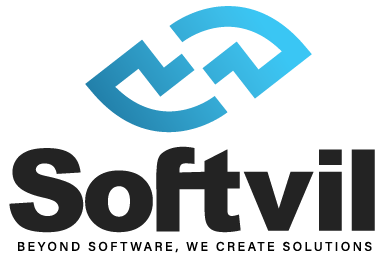In today’s fast-paced business environment, software development and quality assurance are critical to the success of any organization. However, the traditional manual approach to testing and QA can be time-consuming, error-prone, and costly. Robotic Process Automation (RPA) offers a promising solution to these challenges by automating repetitive and rule-based tasks, such as data entry, test case execution, and regression testing. RPA enables organizations to achieve faster time-to-market, increased accuracy, and improved cost efficiency while freeing up skilled testers to focus on higher-value activities such as exploratory testing and analysis. At Softvil Technologies, our RPA expert engineers focus on delivering the best to our clients using RPA solutions in QA automation.
In this article, we will explore the benefits and challenges of RPA in software QA and provide best practices for successful implementation. We will examine specific use cases where RPA has been applied to software testing and quality assurance processes and analyze the results. Additionally, we will discuss the challenges and limitations of RPA and explore how organizations can overcome these obstacles. By understanding the benefits and challenges of RPA in software QA, organizations can make informed decisions about implementing this technology in their testing processes. Finally, we will look at emerging trends and innovations in the field of RPA and their implications for the future of software QA.
Benefits of RPA in Software QA
The adoption of Robotic Process Automation (RPA) in Software Quality Assurance (QA) has become increasingly popular due to the numerous benefits it offers. One of the primary advantages of using RPA in software QA is improved accuracy and consistency. Unlike humans, RPA robots are designed to execute repetitive tasks with great precision, ensuring that each task is performed consistently and with minimal errors. This level of accuracy significantly reduces the likelihood of defects in software applications, thereby improving the overall quality of the software.
RPA also offers increased speed and efficiency in software QA. As mentioned earlier, RPA robots can perform repetitive tasks with greater speed and accuracy than humans, allowing testers to complete more tests in less time. This increased efficiency enables organizations to achieve faster time-to-market and deliver software applications that meet customer requirements promptly. Furthermore, RPA provides enhanced coverage and scalability in software QA. With RPA, organizations can automate a wide range of QA tasks, from test case generation and execution to regression testing and bug tracking. This comprehensive coverage ensures that software applications are thoroughly tested and that any defects are identified and addressed before release. Additionally, RPA enables organizations to scale their QA processes quickly and efficiently to accommodate growing demand.
Examples of RPA in Software QA
Robotic Process Automation (RPA) offers a wide range of use cases in Software Quality Assurance (QA). By automating repetitive and rule-based tasks, RPA frees up skilled testers to focus on higher-value activities such as exploratory testing and analysis. Here are some examples of RPA in software QA:
Test data preparation and cleanup: One of the most time-consuming tasks in software QA is preparing and cleaning up test data. With RPA, organizations can automate the process of generating test data, including creating test users, inputting data, and deleting unnecessary data after the test. This enables testers to focus on more critical testing tasks.
Test case generation and execution: RPA robots can generate test cases based on predefined criteria, execute them automatically, and report the results. This enables organizations to increase test coverage while reducing testing time and costs.
Regression testing and bug tracking: RPA can automate the process of regression testing, which involves testing changes made to an application to ensure that no new defects have been introduced. Additionally, RPA robots can identify and track bugs, automatically report them, and assign them to the relevant team members for resolution.
Continuous integration and delivery: RPA can be integrated with DevOps tools to enable continuous integration and delivery, where code changes are automatically tested, integrated, and deployed. This approach reduces manual errors and enables organizations to deliver software applications more quickly and efficiently.
In conclusion, RPA in software QA offers a wide range of use cases, enabling organizations to automate repetitive and rule-based tasks, increase efficiency, and improve software quality. By automating these tasks, testers can focus on higher-value activities, improving the overall effectiveness of the software QA process.
Challenges of RPA in Software QA
Although Robotic Process Automation (RPA) offers significant benefits in Software Quality Assurance (QA), there are also several challenges associated with its implementation. Here are some challenges of RPA in software QA:
Technical complexity and tool selection: Implementing RPA requires technical expertise and familiarity with automation tools. Additionally, there are multiple RPA tools available in the market, each with their own features and capabilities. Selecting the appropriate tool for the organization’s needs and ensuring that it integrates with existing tools can be challenging.
Security and compliance issues: RPA robots require access to sensitive data and systems, raising concerns about security and compliance. Organizations must ensure that their RPA implementations comply with regulations and security standards, such as GDPR, HIPAA, and ISO 27001.
Human-machine interaction and error handling: RPA robots require human intervention in some cases, such as exception handling and error resolution. Organizations must define clear guidelines for human-robot interaction and ensure that human errors do not compromise the effectiveness of the automation.
Maintenance and updates: Like any other software, RPA robots require maintenance and updates to remain effective. Ensuring that robots are up-to-date and compatible with new systems and tools can be a challenge.
The challenges of RPA in software QA can be significant, but they can be overcome with careful planning and implementation. Organizations must consider technical complexity, security and compliance issues, human-machine interaction and error handling, and maintenance and updates to ensure that their RPA implementations are effective and efficient. By addressing these challenges, organizations can achieve higher software quality, increased efficiency, and reduced costs.
Best practices for implementing RPA in Software QA
Implementing Robotic Process Automation (RPA) in Software Quality Assurance (QA) requires careful planning and execution to ensure success. Here are some best practices for implementing RPA in software QA:
Aligning business goals and metrics: Organizations should define clear business goals and metrics for their RPA implementation, such as reducing testing time, increasing test coverage, and improving software quality. These goals should align with the organization’s overall business strategy and should be regularly reviewed to ensure that they remain relevant.
Collaborating with stakeholders and users: Successful RPA implementation requires collaboration with stakeholders and users, including testers, developers, and business users. Engaging these groups early in the process can help identify use cases, define requirements, and ensure that the RPA implementation meets their needs.
Establishing a governance framework and standards: Organizations should establish a governance framework and standards for RPA implementation. This includes defining roles and responsibilities, creating guidelines for process automation, and ensuring compliance with regulations and security standards.
Providing training and support for RPA users: Training and support are critical for ensuring that RPA users are equipped to use the technology effectively. Organizations should provide comprehensive training programs for users, including training on RPA tools, process automation, and exception handling. Additionally, organizations should establish support channels for users to address any issues that arise during implementation.
In summary
Robotic Process Automation (RPA) can offer significant benefits to software Quality Assurance (QA), including improved accuracy, efficiency, coverage, scalability, and cost savings. Examples of RPA in software QA include test data preparation, test case generation, regression testing, and continuous integration and delivery. However, challenges such as technical complexity, security, human-machine interaction, and maintenance must be addressed for successful implementation. Best practices for implementing RPA in software QA include aligning business goals, collaborating with stakeholders, establishing governance frameworks, and providing training and support for RPA users. Overall, organizations can achieve higher software quality, increased efficiency, and reduced costs by leveraging RPA in software QA. Contact Softvil Technologies today for a free consultation on how to improve your software QA using RPA solutions.

